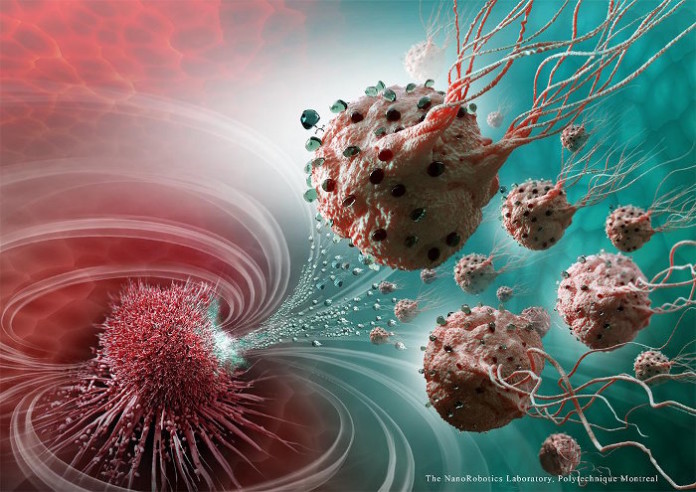
“These legions of nanorobotic agents were actually composed of more than 100 million flagellated bacteria – and therefore self-propelled – and loaded with drugs that moved by taking the most direct path between the drug’s injection point and the area of the body to cure,” said Sylvain Martel, Director of the Polytechnique Montréal Nanorobotics Laboratory, and senior study author.
The technology sounds like science fiction come-to-life. The microbes behind this so-called legions of nanorobots are magnetotactic bacteria (Magnetococcus marinus strain MC-1). Discovered by Richard P. Blakemore in 1975, magnetotactic bacteria are tiny microorganisms that have the capacity to convert iron into magenetite inside organelles called magnetosomes. Each of the magnetite crystal acts as a nano-magnet, and a chain of these act as a built-in compass for north and south detection. The bacteria use these internal compasses to move and align themselves in watery regions with optimal oxygen concentrations.
Martel and his team exploited the unique characteristics of the magnetotactic bacteria to ferry drug-loaded lipososomes into tumors. In particular, M. marinus has a penchant for regions of low oxygen concentration. This makes them ideal carriers of chemotherapy drugs to tumors, since many contain hypoxic regions that are often resistant to therapies.
In mice experiments, Martel and his team showed the nanorobots could deliver drugs in a targeted fashion to colorectal tumors. “The drug’s propelling force was enough to travel efficiently and enter deep inside the tumors,” he added.
The concept of using the bacteria-propelled nanorobots to control and target drug release could potentially minimize the chemotherapy-related collateral damages to the healthy cells. Furthermore, because of higher precision to the tumor, doctors may be able to use a lower dose of the drug to achieve the same potency. This would also curtail side-effects of chemotherapy.
“This innovative use of nanotransporters will have an impact not only on creating more advanced engineering concepts and original intervention methods, but it also throws the door wide open to the synthesis of new vehicles for therapeutic, imaging and diagnostic agents,” said Martel. “Chemotherapy, which is so toxic for the entire human body, could make use of these natural nanorobots to move drugs directly to the targeted area, eliminating the harmful side effects while also boosting its therapeutic effectiveness.”
Source: LabRoots


















































